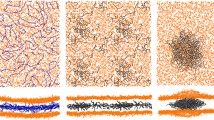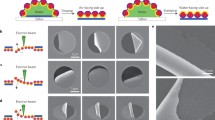Abstract
The main phase transition temperature of a lipid membrane, which is vital for its biomedical applications such as controllable drug release, can be regulated by encapsulating hydrophobic nanoparticles into the membrane. However, the exact relationship between surface properties of the encapsulating nanoparticles and the main phase transition temperature of a lipid membrane is far from clear. In the present work, we performed coarse-grained molecular dynamics simulations to meet this end. The results show the surface roughness of nanoparticles and the density of surface-modifying molecules on the nanoparticles are responsible for the regulation. Increasing the surface roughness of the nanoparticles increases the main phase transition temperature of the lipid membrane, whereas it can be decreased in a nonlinear way via increasing the density of surface-modifying molecules on the nanoparticles. The results may provide insights for understanding recent experimental studies and promote the applications of nanoparticles in controllable drug release by regulating the main phase transition temperature of lipid vesicles.

Similar content being viewed by others
References
Al-Jamal, W.; Kostarelos, K. Liposome-nanoparticle hybrids for multimodal diagnostic and therapeutic applications. Nanomedicine 2007, 2, 85–98.
Zhang, L. F.; Granick, S. How to stabilize phospholipid liposomes (using nanoparticles). Nano Lett. 2006, 6, 694–698.
Wang, B.; Zhang, L. F.; Bae, S. C.; Granick, S. Nanoparticle-induced surface reconstruction of phospholipid membranes. Proc. Natl. Acad. Sci. U.S.A. 2008, 105, 18171–18175.
Urban, A. S.; Fedoruk, M.; Horton, M. R.; Rädler, J. O.; Stefani, F. D.; Feldmann, J. Controlled nanometric phase transitions of phospholipid membranes by plasmonic heating of single gold nanoparticles. Nano Lett. 2009, 9, 2903–2908.
Chen, Y. J.; Bose, A.; Bothun, G. D. Controlled release from bilayer-decorated magnetoliposomes via electromagnetic heating. ACS Nano 2010, 4, 3215–3221.
Amstad, E.; Kohlbrecher, J.; Müller, E.; Schweizer, T.; Textor, M.; Reimhult, E. Triggered release from liposomes through magnetic actuation of iron oxide nanoparticle containing membranes. Nano Lett. 2011, 11, 1664–1670.
An, X. Q.; Zhan, F.; Zhu, Y. Y. Smart photothermal-triggered bilayer phase transition in AuNPs-liposomes to release drug. Langmuir 2013, 29, 1061–1068.
Gopalakrishnan, G.; Danelon, C.; Izewska, P.; Prummer, M.; Bolinger, P.-Y.; Geissbhler, I.; Demurtas, D.; Dubochet, J.; Vogel, H. Multifunctional lipid/quantum dot hybrid nanocontainers for controlled targeting of live cells. Angew. Chem. Int. Ed. 2006, 45, 5478–5483.
Marshall, J. D.; Schnitzer, M. J. Optical strategies for sensing neuronal voltage using quantum dots and other semiconductor nanocrystals. ACS Nano 2013, 7, 4601–4609.
Qiao, R.; Roberts, A. P.; Mount, A. S.; Klaine, S. J.; Ke, P. C. Translocation of C60 and its derivatives across a lipid bilayer. Nano Lett. 2007, 7, 614–619.
Lin, X. B.; Li, Y.; Gu, N. Nanoparticle’s size effect on its translocation across a lipid bilayer: A molecular dynamics simulation. J. Comput. Theor. Nanosci. 2010, 7, 269–276.
Ginzburg, V. V.; Balijepalli, S. Modeling the thermodynamics of the interaction of nanoparticles with cell membranes. Nano Lett. 2007, 7, 3716–3722.
Nangia, S.; Sureshkumar, R. Effects of nanoparticle charge and shape anisotropy on translocation through cell membranes. Langmuir 2012, 28, 17666–17671.
Wang, H. M.; Michielssens, S.; Moors, S. L. C.; Ceulemans, A. Molecular dynamics study of dipalmitoylphosphatidylcholine lipid layer self-assembly onto a single-walled carbon nanotube. Nano Res. 2009, 2, 945–954.
Lehn, R. C. V.; Atukorale, P. U.; Carney, R. P.; Yang, Y. S.; Stellacci, F.; Irvine, D. J.; Alexander-Katz, A. Effect of particle diameter and surface composition on the spontaneous fusion of monolayer-protected gold nanoparticles with lipid bilayers. Nano Lett. 2013, 13, 4060–4067.
Grzelczak, M.; Perez-Juste, J.; Mulvaney, P.; Liz-Marzan, L. M. Shape control in gold nanoparticle synthesis. Chem. Soc. Rev. 2008, 37, 1783–1791.
Alkilany, A. M.; Lohse, S. E.; Murphy, C. J. The gold standard: Gold nanoparticle libraries to understand the nanobio interface. Acc. Chem. Res. 2013, 46, 650–661.
Sun, Y. Controlled synthesis of colloidal silver nanoparticles inorganic solutions: Empirical rules for nucleation engineering. Chem. Soc. Rev. 2013, 42, 2497–2511.
Kim, S. T.; Saha, K.; Kim, C.; Rotello, V. M. The role of surface functionality in determining nanoparticle cytotoxicity. Acc. Chem. Res. 2013, 46, 681–691.
Rasch, M. R.; Rossinyol, E.; Hueso, J. L.; Goodfellow, B. W.; Arbiol, J.; Korgel, B. A. Hydrophobic gold nanoparticle self-assembly with phosphatidylcholine lipid: Membraneloaded and Janus vesicles. Nano Lett. 2010, 10, 3733–3739.
Rasch, M. R.; Yu, Y.; Bosoy, C.; Goodfellow, B. W.; Korgel, B. A. Chloroform-enhanced incorporation of hydrophobic gold nanocrystals into dioleoylphosphatidylcholine (DOPC) vesicle membranes. Langmuir 2012, 28, 12971–12981.
Lee, H.-Y.; Shin, S. H. R.; Abezgauz, L. L.; Lewis, S. A.; Chirsan, A. M.; Danino, D. D.; Bishop, K. J. M. Integration of gold nanoparticles into bilayer structures via adaptive surface chemistry. J. Am. Chem. Soc. 2013, 135, 5950–5953.
Park, S.-H.; Oh, S.-G.; Mun, J.-Y.; Han, S.-S. Effects of silver nanoparticles on the fluidity of bilayer in phospholipid liposome. Colloid Surf. B 2005, 44, 117–122.
Park, S.-H.; Oh, S.-G.; Mun, J.-Y.; Han, S.-S. Loading of gold nanoparticles inside the DPPC bilayers of liposome and their effects on membrane fluidities. Colloid Surf. B 2006, 48, 112–118.
Bothun, G. D. Hydrophobic silver nanoparticles trapped in lipid bilayers: Size distribution, bilayer phase behavior, and optical properties. J. Nanobiotechnol. 2008, 6, 13.
White, G. V.; Chen, Y. J.; Roder-Hanna, J.; Bothun, G. D.; Kitchens, C. L. Structural and thermal analysis of lipid vesicles encapsulating hydrophobic gold nanoparticles. ACS Nano 2012, 6, 4678–4685.
Nagle, J. F. Theory of the main lipid bilayer phase transition. Ann. Rev. Phys. Chem. 1980, 31, 157–195.
Marrink, S. J.; Risselada, H. J.; Yefimov, S.; Tieleman, D. P.; de Vries, A. H. The MARTINI force field: Coarse grained model for biomolecular simulations. J. Phys. Chem. B 2007, 111, 7812–7824.
Ramalho, J. P. P.; Gkeka, P.; Sarkisov, L. Structure and phase transformations of DPPC lipid bilayers in the presence of nanoparticles: Insights from coarse-grained molecular dynamics simulations. Langmuir 2011, 27, 3723–3730.
Rodgers, J. M.; Sørensen, J.; de Meyer, F. J.-M.; Schiøtt, B.; Smit, B. Understanding the phase behavior of coarse-grained model lipid bilayers through computational calorimetry. J. Phys. Chem. B 2012, 116, 1551–1569.
Hakobyan, D.; Heuer, A. Phase separation in a lipid/cholesterol system: Comparison of coarse-grained and united-atom simulations. J. Phys. Chem. B 2013, 117, 3841–3851.
Waheed, Q.; Tjörnhammar, R.; Edholm, O. Phase transitions in coarse-grained lipid bilayers containing cholesterol by molecular dynamics simulations. Biophys. J. 2012, 103, 2125–2133.
Marrink, S. J.; Tieleman, D. P. Perspective on the Martini model. Chem. Soc. Rev. 2013, 42, 6801–6822.
Li, Y.; Chen, X.; Gu, N. Computational investigation of interaction between nanoparticles and membranes: Hydrophobic/hydrophilic effect. J. Phys. Chem. B 2008, 112, 16647–16653.
Li, Y.; Gu, N. Thermodynamics of charged nanoparticle adsorption on charge-neutral membranes: A simulation study. J. Phys. Chem. B 2010, 114, 2749–2754.
Lin, X. B.; Wang, C. L.; Wang, M.; Fang, K.; Gu, N. Computer simulation of the effects of nanoparticles’ adsorption on the properties of supported lipid bilayer. J. Phys. Chem. C 2012, 116, 17960–17968.
Vácha, R.; Martinez-Veracoechea, F. J.; Frenkel, D. Receptor-mediated endocytosis of nanoparticles of various shapes. Nano Lett. 2011, 11, 5391–5395.
Vácha, R.; Martinez-Veracoechea, F. J.; Frenkel, D. Intracellular release of endocytosed nanoparticles upon a change of ligand-receptor interaction. ACS Nano 2012, 6, 10598–10605.
Yue, T. T.; Zhang, X. R. Cooperative effect in receptor-mediated endocytosis of multiple nanoparticles. ACS Nano 2012, 6, 3196–3205.
Li, Y.; Yue, T. T.; Yang, K.; Zhang, X. R. Molecular modeling of the relationship between nanoparticle shape anisotropy and endocytosis kinetics. Biomaterials 2012, 33, 4965–4973.
Huang, C. J.; Zhang, Y.; Yuan, H. Y.; Gao, H. J.; Zhang, S. L. Role of nanoparticle geometry in endocytosis: Laying down to stand up. Nano Lett. 2013, 13, 4546–4550.
Yang, K.; Ma, Y.-Q. Computer simulation of the translocation of nanoparticles with different shapes across a lipid bilayer. Nat. Nanotechnol. 2010, 5, 579–583.
Ding, H.-M.; Tian, W.-D.; Ma, Y.-Q. Designing nanoparticle translocation through membranes by computer simulations. ACS Nano 2012, 6, 1230–1238.
Ding, H.-M.; Ma, Y.-Q. Controlling cellular uptake of nanoparticles with pH-sensitive polymers. Sci. Rep. 2013, 3, 2804.
Berendsen, H. J. C.; Postma, J. P. M.; van Gunsteren, W. F.; DiNola, A.; Haak, J. R. Molecular dynamics with coupling to an external bath. J. Chem. Phys. 1984, 81, 3684–3690.
Humphrey, W.; Dalke, A.; Schulten, K. VMD: Visual molecular dynamics. J. Mol. Graph. 1996, 14, 33–38.
Hess, B.; Kutzner, C.; van der Spoel, D.; Lindahl, E. GROMACS 4: Algorithms for highly efficient, load-balanced, and scalable molecular simulation. J. Chem. Theory Comput. 2008, 4, 435–447.
Koynova, R.; Caffrey, M. Phases and phase transitions of the phosphatidylcholines. Biochim. Biophys. Acta 1998, 1376, 91–145.
Nagle, J. F.; Tristram-Nagle, S. Structure of lipid bilayers. Biochim. Biophys. Acta 2000, 1469, 159–195.
Kong, X.; Qin, S. S.; Lu, D. N.; Liu, Z. Surface tension effects on the phase transition of a DPPC bilayer with and without protein: A molecular dynamics simulation. Phys. Chem. Chem. Phys. 2014, 16, 8434–8440.
Marrink, S. J.; Risselada, J.; Mark, A. E. Simulation of gel phase formation and melting in lipid bilayers using a coarse grained model. Chem. Phys. Lipids 2005, 135, 223–244.
Marrink, S. J.; de Vries, A. H.; Mark, A. E. Coarse grained model for semiquantitative lipid simulations. J. Phys. Chem. B 2004, 108, 750–760.
Mecke, A.; Majoros, I. J.; Patri, A. K.; Baker Jr, J. R.; Holl, M. M. B.; Orr, B. G. Lipid bilayer disruption by polycationic polymers: The roles of size and chemical functional group. Langmuir 2005, 21, 10348–10354.
Shen, C. Y.; Lazouskaya, V.; Zhang, H. Y.; Wang, F.; Li, B. G.; Jin, Y.; Huang, Y. F. Theoretical and experimental investigation of detachment of colloids from rough collector surfaces. Colloid Surf. A 2012, 410, 98–110.
Shen, C. Y.; Wang, F.; Li, B. G.; Jin, Y.; Wang, L.-P.; Huang, Y. F. Application of DLVO energy map to evaluate interactions between spherical colloids and rough surfaces. Langmuir 2012, 28, 14681–14692.
Shen, C. Y.; Lazouskaya, V.; Zhang, H. Y.; Li, B. G.; Jin, Y.; Huang, Y. F. Influence of surface chemical heterogeneity on attachment and detachment of microparticles. Colloid Surf. A 2013, 433, 14–29.
Author information
Authors and Affiliations
Corresponding author
Electronic supplementary material
Rights and permissions
About this article
Cite this article
Lin, X., Gu, N. Surface properties of encapsulating hydrophobic nanoparticles regulate the main phase transition temperature of lipid bilayers: A simulation study. Nano Res. 7, 1195–1204 (2014). https://doi.org/10.1007/s12274-014-0482-3
Received:
Revised:
Accepted:
Published:
Issue Date:
DOI: https://doi.org/10.1007/s12274-014-0482-3




